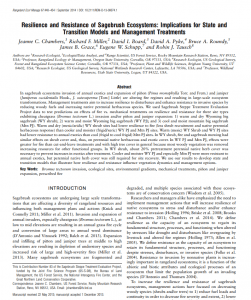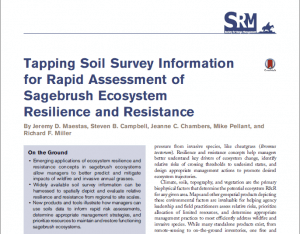Research and Publications
View article.
At seven focus groups held across the United States, natural resource professionals were asked how they found the science needed to do their jobs. Although searching for science online was mentioned in all groups and by all demographics, how search results were used differed. Early-career professionals used them to find scientific articles to read. Mid- to late-career professionals used them to identify author(s) to contact to discuss results. Open access articles were highly preferred. Viewing webinars and videos was also mentioned frequently. Webinars are falling out of favor while short videos are becoming more popular. Attending scientific meetings remains a preferred approach, but professionals later in their career like them for different reasons than early-career professionals. The two career cohorts also differ in why they like electronic newsletters. Rapid adoption of new technologies to disseminate science has already impacted professionals’ behavior, yet it is not clear that researchers have kept up.
View article.
Using a chronosequence approach, cover of vascular plants and biocrusts was examined across chronic disturbance gradients related to invasion by exotic species and grazing by livestock, following the acute disturbance of fire using paired burned and unburned plots in Wyoming big sagebrush on 99 plots. Results Cover of vascular plants and biocrusts was related to disturbance more so than abiotic factors of precipitation following fire, soil chemistry, percent coarse fragment and heat load index. Over time since fire of 12–23 years, we saw recovery of early successional groups: short mosses, shallow-rooted perennial grasses and annual forbs. Cover of deep and shallow-rooted perennial grasses and annual forbs increased in cover with intermediate levels of disturbance. Perennial forbs lacked a clear relationship with disturbance. Biocrusts decreased in cover with less disturbance when compared with perennial herbaceous plants but differed in sensitivities. Tall mosses were less sensitive to disturbance compared with lichens. Short mosses increased with some disturbance.
View report.
A group of people knowledgeable about wildland fire have produced a 52-page document that attempts to assemble and summarize areas of agreement and disagreement regarding the management of forested areas in the western United States. Calling themselves the Fire Research Consensus Working Group, they looked for areas of common ground to provide insights for scientists and land managers with respect to recent controversies over the role of low-, moderate-, and high-severity fires.
View paper.
This study evaluated the effect of herbicide (imazapic) applied in the first winter or second fall after the 113,000 ha Soda wildfire on the target exotic annual grasses and also key non-target components of the plant community. Cover of exotic annual grass cover, but not of deep-rooted perennial bunchgrass, was less where imazapic had been applied, whereas more variability was evident in the response of Sandberg bluegrass and seeded shrubs and forbs. Regression-tree analysis of the subset of plots measured both before and after the second fall application revealed greater reductions of exotic annual grass cover in places where their cover was <42% before spraying. Otherwise, imazapic effects did not vary with the landscape factors we analyzed.
View guide.
Long-term vegetation dynamics across public rangelands in the western United States are not well understood because of the lack of large-scale, readily available historic datasets. The Bureau of Land Management’s Soil-Vegetation Inventory Method (SVIM) program was implemented between 1977 and 1983 across 14 western states, but the data have not been easily accessible. This guide introduces the SVIM vegetation cover dataset in a georeferenced, digital format; summarizes how the data were collected; and discuss potential limitations and biases. It demonstrates how SVIM data can be compared with contemporary monitoring datasets to quantify changes in vegetation associated with wildfire and the abundance of exotic invasive species. Specifically, it compares SVIM vegetation cover data with cover data collected by BLM’s Assessment, Inventory, and Monitoring (AIM) program (2011–2016) in a focal area in the northern Great Basin. Comparisons between historic SVIM data and recent AIM data documented significant declines in the occupancy and cover of native shrubs and native perennial forbs, and a significant increase in exotic annual forbs. Our study demonstrates that SVIM data will be an important resource for researchers interested in quantifying vegetation change through time across public rangelands in the western United States.
View paper.
This paper (1) provides a review of conditions under which historic reference information is and is not required to meet management and policy objectives, (2) summarizes current approaches to defining the reference for land health and degradation assessments, and (3) presents a protocol, “Describing Indicators of Rangeland Health” (DIRH) for collecting and organizing data that can be used to define a historic reference. This protocol builds on the framework and indicators presented in the “Interpreting Indicators of Rangeland Health” (IIRH). IIRH uses a combination of scientific and local knowledge to generate soil- and climate-specific assessments of three attributes of land health. It is used in a number of countries. In the United States, data are aggregated over 30,000 locations to provide national assessments.
View article.
In this study, we used longer-term data to evaluate the relationships among soil climate conditions, perennial herbaceous cover, and cheatgrass cover following fuel management treatments across the environmental gradients that characterize sagebrush ecosystems in the Great Basin. Both prescribed fire and mechanical treatments increased soil water availability on woodland sites and perennial herbaceous cover on some woodland and sagebrush sites. Prescribed fire also slightly increased soil temperatures and especially increased cheatgrass cover compared to no treatment and mechanical treatments on most sites. Non-metric dimensional scaling ordination and decision tree partition analysis indicated that sites with warmer late springs and warmer and wetter falls had higher cover of cheatgrass. Sites with wetter winters and early springs (March-April) had higher cover of perennial herbs. Our findings suggest that site resistance to cheatgrass after fire and fuel control treatments decreases with a warmer and drier climate. This emphasizes the need for management actions to maintain and enhance perennial herb cover, such as implementing appropriate grazing management, and revegetating sites that have low abundance of perennial herbs in conjunction with fuel control treatments.
View article.
In sagebrush ecosystems invasion of annual exotics and expansion of pinyon and juniper are altering fire regimes and resulting in large-scale ecosystem transformations. Management treatments aim to increase resilience to disturbance and enhance resistance to invasive species by reducing woody fuels and increasing native perennial herbaceous species. This study used Sagebrush Steppe Treatment Evaluation Project data to test predictions on effects of fire vs. mechanical treatments on resilience and resistance for three site types. Warm (mesic) WY Shrub and WY PJ sites had lower resistance to annual exotics than cool (frigid to cool frigid) Mtn PJ sites. In WY shrub, fire and sagebrush mowing had similar effects on shrub cover and, thus, on perennial native herbaceous and exotic cover. In WY PJ and Mtn PJ, effects were greater for fire than cut-and-leave treatments and with high tree cover in general because most woody vegetation was removed increasing resources for other functional groups. In WY shrub, about 20% pretreatment perennial native herb cover was necessary to prevent increases in exotics after treatment. Cooler and moister WY PJ and especially Mtn PJ were more resistant to annual exotics, but perennial native herb cover was still required for site recovery. We use our results to develop state and transition models that illustrate how resilience and resistance influence vegetation dynamics and management options.
View article.
On the Ground Emerging applications of ecosystem resilience and resistance concepts in sagebrush ecosystems allow managers to better predict and mitigate impacts of wildfire and invasive annual grasses. Widely available soil survey information can be harnessed to spatially depict and evaluate relative resilience and resistance from regional to site scales. New products and tools illustrate how managers can use soils data to inform rapid risk assessments, determine appropriate management strategies, and prioritize resources to maintain and restore functioning sagebrush ecosystems.
View article.
This study developed range-wide population and habitat models for greater sage-grouse (Centrocercus urophasianus) that account for regional variation in habitat selection and relative densities of birds for use in conservation planning and risk assessments. The models demonstrate distinct clustering of relative abundance of sage-grouse populations across all management zones. On average approximately half of the breeding population is predicted to be within 10% of the occupied range. We also found 80% of sage-grouse populations were contained in 25 – 34% of the occupied range within each management zone. Range-wide population and habitat models account for regional variation in habitat selection and the relative densities of birds, thus they can serve as a consistent and common currency to assess how sage-grouse habitat and populations overlap with conservation actions or threats over the entire sage-grouse range.




